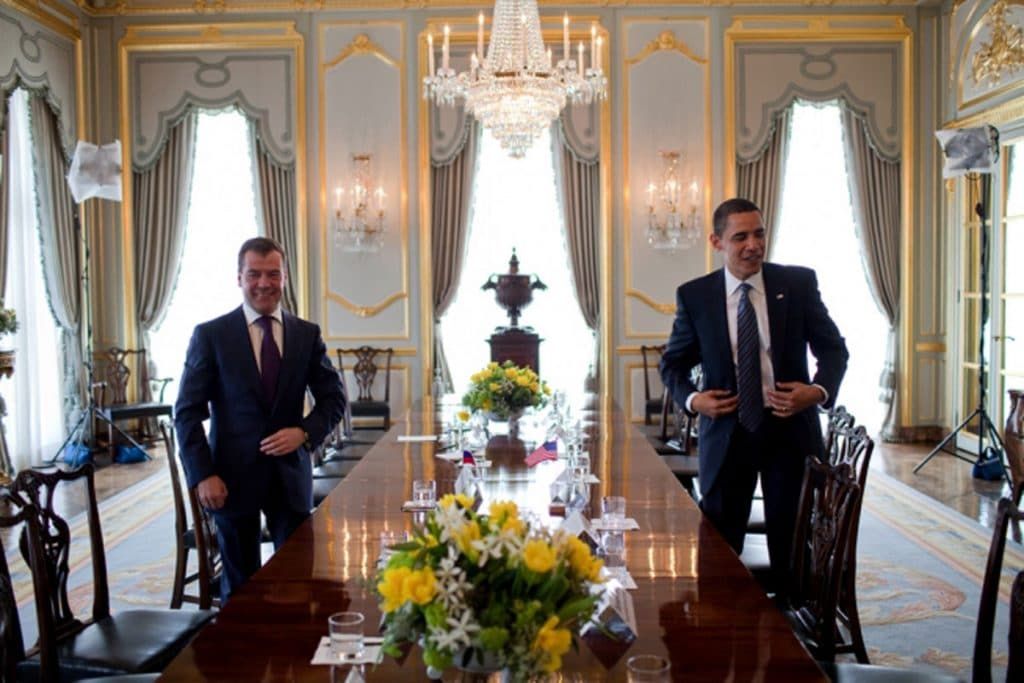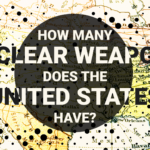New START: To succeed, plan for failure
By John Erath | June 1, 2023
 Then-US President Barack Obama and then-Russian President Dmitry Medvedev issue a joint statement announcing their pursuit of a New START treaty in London in April 2009. (White House photo by Pete Souza.)
Then-US President Barack Obama and then-Russian President Dmitry Medvedev issue a joint statement announcing their pursuit of a New START treaty in London in April 2009. (White House photo by Pete Souza.)
Sometimes, the best way to succeed is to be prepared to fail. This is particularly true in the world of diplomacy, and even more so of arms control.
Over the past year, there has been concern in the arms control community about the future of the New Strategic Arms Reduction Treaty (New START), sometimes referred to as, if somewhat misleadingly, the last remaining arms control agreement. Such concern is understandable. Without New START’s limits, there would no longer be a legal obstacle keeping the United States and Russia from following China’s lead and dramatically increasing—their nuclear arsenals.
With New START set to expire in 2026, the options seem clear: Either both countries find a way to extend the treaty’s limits, or they should prepare for a new and ruinously expensive arms race. Given the difficulty of securing congressional approval on anything, some experts have suggested informal arrangements to preserve treaty limits on nuclear numbers. Although it would seem clearly in the interests of both New START parties—as well as China’s—to avoid unconstrained buildups of nuclear arsenals, preserving the treaty’s limits requires more than Washington’s willingness to do so. New START is bilateral, and its fate will depend at least as much on Russia’s decisions and actions as anything happening inside the Beltway. And it won’t be easy.
Several years ago, while on a diplomatic assignment, I was tasked with securing agreement from a Russian delegation on what was apparently a purely procedural issue. It was the sort of question that should have been resolved in 30 seconds at most, simply as a matter of convenience and without debate and according to established precedent. My Russian counterpart saw the situation as the US delegation asking for something and immediately wanted to know what concessions we were willing to grant in return for Russia giving us what we wanted. In the end, nothing happened, as I was not authorized to concede anything, and senior level people had to resolve a trivial technical point before real dialogue could take place. This illustrates a typical Russian approach to negotiation: try to get something for nothing, or make the other side pay a price merely to begin the process. It would be as though one were interested in buying a used car and the dealer asked for a “convenience” fee to walk on the lot and view the options.
By this logic, approaching the Russian government with even a seemingly simple suggestion to preserve New START, or its essential limitations, beyond 2026 could end up undermining the chances for the treaty’s continuation. Regardless of the benefits, Moscow may perceive this as an opportunity to seek concessions from Washington. The more it seems that preserving New START is important to the United States and NATO, the greater the likelihood that Russia will seek to leverage it, or at least test to see if Washington wants it badly enough to throw some concessions Moscow’s way.
Therefore, there are two questions to be answered. First, is the treaty, or at least its numerical limits, worth keeping? For now, it is, although China’s apparent efforts to increase its nuclear force without any transparency could eventually change the calculus. New START’s limits are sufficient for deterrence against any nuclear power in the near term, and no country—least of all Russia—needs the costly burden of building and maintaining hundreds of additional nuclear weapons. Of course, Russia cheats on arms control agreements when it feels it in its interests to do so—as it did with the Conventional Forces in Europe Treaty and the Intermediate-range Nuclear Forces Treaty. But the level of non-compliance with New START limits necessary to change strategic calculations would be impossible to conceal, even without the treaty’s verification system.
The second question, then, is how to design a diplomatic approach to prevent a situation in which the United States is asked to pay a price for the status quo. The key is patience and avoiding giving any perception of desperation. After all, Russia may also correctly realize that observing New START limits is in its interest. It could then propose doing so on its own or may respond positively to signals that the United States will continue to abide by said limits as long as Russia does. In the end, however, the best way to preserve the stability of New START may be to be prepared to let it go.
This is not to say that the United States should abandon New START or any other arms control agreement. Instead, one should allow Russia to understand that such measures have value beyond that of a negotiating chip and meanwhile prepare for an alternative approach, so the value of arms control does not stagnate. Arms control is a tool, and a valuable one: Formal bilateral treaties generally have been the vehicle for its use, so they were pursued with success for decades. But treaties were never an end in themselves. Rather, the goal of arms control has always been to reduce the risk of nuclear war, and bilateral agreements between perceived adversaries remain one most valuable means to achieve it.
With Russia’s suspension of New START in February, the dynamic has changed. It is therefore important to plan now for what might supplement traditional bilateral treaties accounting for Russia’s proclivity for less-than-candid negotiating. Such plans could include resuming information exchanges or employing advanced technologies to provide a measure of confidence that no illicit activities are occurring, therefore avoiding an unconstrained arms race and all the dangers it would bring. Put another way, preserving arms control as a tool to lower risks of nuclear war is more important than saving a treaty at any cost.
This may seem a paradox. Yet in a world where “peaceful nuclear explosions” have passed without too much comment and invading neighbors and massacring civilians can be explained as preventing genocide, it may not be too unreasonable to consider a strategy based on previous behaviors and plan for a difficult path ahead.
Good diplomacy depends on strategic thinking and planning for “less-than-ideal” eventualities. Such should be the case when mapping out a future for nuclear arms control. If we want New START to be part of that future, the key will be to know how to start—and not to start—the negotiation.
Together, we make the world safer.
The Bulletin elevates expert voices above the noise. But as an independent nonprofit organization, our operations depend on the support of readers like you. Help us continue to deliver quality journalism that holds leaders accountable. Your support of our work at any level is important. In return, we promise our coverage will be understandable, influential, vigilant, solution-oriented, and fair-minded. Together we can make a difference.
Keywords: New START, Strategic Arms Reduction Treaty, US-Russia relations, arms control
Topics: Nuclear Weapons, Opinion















